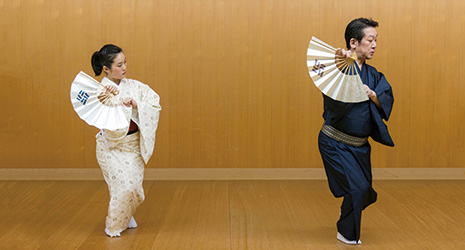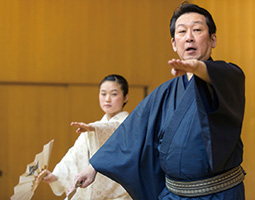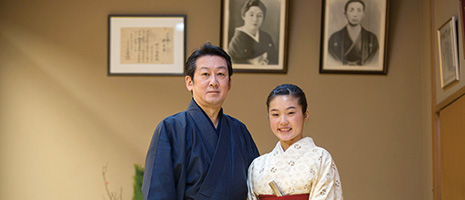February 2020
The Slow-Burn Appeal of Nihonbuyo

The ancient performing art that is Nihonbuyo “is Japanese dance itself,” and in more than just name.
Nishikawa Kei stands beside her father, Minosuke, and replicates his shuffling steps, supple tilts of the neck and graceful hand movements, which are punctuated by deft flourishes of a folding fan.

Minosuke makes frequent glances over his shoulder, scrutinizing his daughter’s every move, made to the sounds of traditional shamisen guitar, tsuzumi drums and meandering song, and offers words of encouragement as she rehearses a dance of the ancient Nihonbuyo (literally “Japanese dance”) tradition.
Kei started dancing at the age of two years and nine months, and just nine months later, she says, “Before I knew it, I had made my stage debut.” That was a turning point. “Performing was fun.”
Starting at such a tender age is a common custom, explains Minosuke, who was also just a toddler when his father, Nishikawa Senzo, first put him through his paces at the Nishikawa School in Tokyo. Established over 300 years ago, the Nishikawa School is the oldest of the five major schools of the Nihonbuyo tradition. The school has nurtured a long line of revered performers, among them Senzo. Current Head Master Senzo has received numerous awards, including the prestigious title of Living National Treasure, which was bestowed upon him in 1999.
“We all start as children, so learning is from feeling, not theory,” says Minosuke, a Nihonbuyo master whose career spans some fifty-seven years. “This is probably true of all Japanese classical performing arts. Performers acquire the skills naturally and in the case of Nihonbuyo with the instructor teaching at the student’s side.”
This has long been the way in a dance genre that began around 400 years ago, but whose roots go back even further to some of Japan’s oldest performing arts.
According to the website of the Nihonbuyo Kyokai (Japanese Classical Dance Association, or JCDA), Nihonbuyo “is Japanese dance itself,” and in more than just name. Over the centuries it has incorporated elements and “the essence” of many Japanese traditional folk dances and performing arts, such as bugaku court dance and noh plays, the JCDA says.
And with time this amalgam of dances has been refined to form what is arguably the quintessential Japanese performing art.
According to Minosuke, a major influence in this mixtape genre is the dance found in kabuki, which helps explain the exquisite kimono, headdresses and accessories worn in Nihonbuyo performances.
“Kabuki was a performance entertainment that regular people themselves couldn’t do,” Minosuke explains of the UNESCO-protected theater. “However, people who saw the dance in kabuki wanted to try it themselves and it gradually became an independent identity.”
That entity was Nihonbuyo, whose popularity spread during the Meiji period (1868–1912), when schools and troupes began to flourish, he adds.
And while the post-World War II penchant for anything western has led to a decline in its popularity, largely due to the growth of imported competitors such as ballet and ballroom dancing, today there are still some 120 schools affiliated to the JCDA, which has twenty-six branches nationwide and 5,000 members.
Minosuke believes actually dancer numbers are in the tens of thousands – 90 percent of them female.
Minosuke himself was less interested in the art as a teenager and it was only later while studying modern dance at the prestigious Laban Center in London (today known as the Trinity Laban Conservatoire of Music and Dance) that he began to fully appreciate what he had left behind in Japan.
He has since devoted his time to spreading the word of Nihonbuyo, wowing audiences both domestically and overseas.
During the upcoming 2020 Tokyo Olympics, too, Minosuke is playing an instrumental part in a JCDA initiative to give performances at the National Theater specifically targeting foreign visitors, he says.
An overriding element of Nihonbuyo that he would like foreigners to appreciate is the subtle, slow-burner nature of the genre, which differs from many more elaborate dances in the West, he says.
Its understated charm reflects the more reserved nature of the Japanese people, says Minosuke.
“This is not a hell-for-leather culture, but one that simmers gently from within and is more reserved,” he says. “That’s the kind of thing I want foreign visitors to feel when they watch a performance.”
Minosuke’s second daughter, Nao, 14, is also a Nihonbuyo performer, and like Kei wants to spread Nihonbuyo to a wider audience. “There are many people who don’t know about Nihonbuyo and I want to raise awareness even if only to a few people,” says Kei. “That goes for people from overseas. I want them to become interested, too.”


